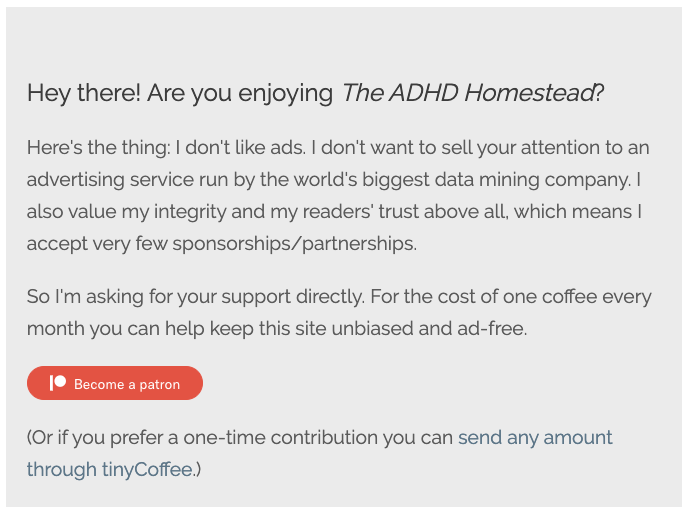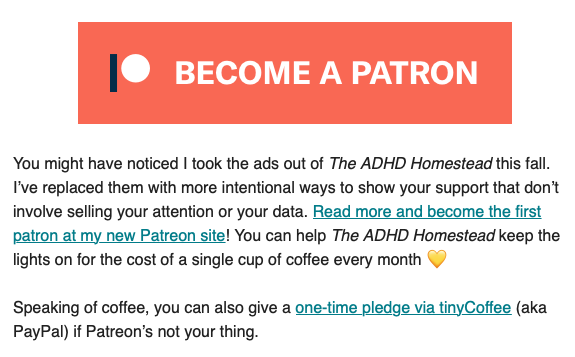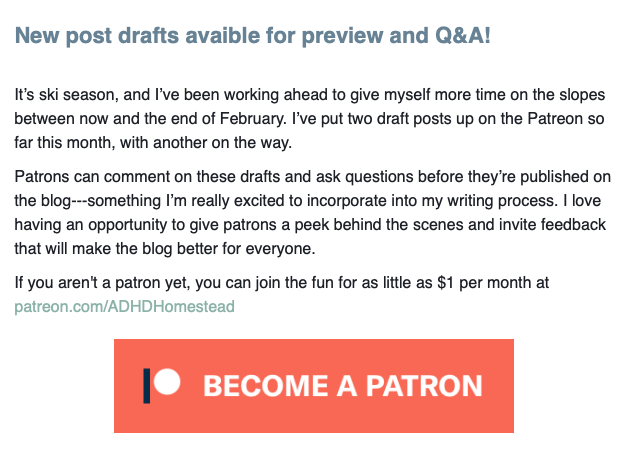[click_to_tweet tweet=”You can get ad revenue from a viral blog post, but that money means nothing tomorrow. It doesn’t predict who will return to your site, sign up for your email list, or buy your next book. All it tells you is you wrote one good headline. #authorplatform” quote=”You can get ad revenue from a viral blog post, but that money means nothing tomorrow. It doesn’t predict who will return to your site, sign up for your email list, or buy your next book. All it tells you is you wrote one good headline. #authorplatform”]
I took my online platform ad-free almost five months ago to align my revenue streams more closely with my mission. My dislike for ads made them ineffective anyway. Between the number of ad categories I blocked and how I shoved them out of the way in my site design, they didn’t earn me much money. Removing them had a negligible impact on my income.
Several months in, I actually haven’t lost any money on my choice. In fact, my income from alternative sources has increased. I figured it was time for an update on what I’m doing and how it’s going.
How I replaced ads on my blog
I didn’t just strip out ads and call it a day: I replaced them with alternatives that supported my values and mission. In the spaces formerly occupied by ads in The ADHD Homestead’s sidebar, I put a new tinyCoffee widget. The widget explained why I didn’t have ads and invited visitors to “buy the author a coffee.”
Money sent through tinyCoffee comes directly to me through PayPal. I like this model because it fosters an intentional relationship based on quality content, not click volume.
This new relationship focus made me comfortable putting requests for support in places I never would’ve displayed ads. For example, I took a little inspiration from The Guardian and added a call to action at the bottom of each blog post:
I also experimented with various messages in my monthly ADHDgram email newsletter:
I typically use Facebook to reshare content rather than sell books or ask for support (working on changing that). However, I put a little message up there to announce my new Patreon:
For a long time I tried to avoid pushing my book in my email newsletter. People value the ADHDgram a lot — often more than The ADHD Homestead itself — and I didn’t want to make it a nonstop sales pitch. That backfired when I realized half of those loyal subscribers didn’t even know I had a book out.
I can only count on 25 percent of subscribers even reading any given email and I get a healthy number of new subscribers each month. That means I need to repeat my messaging more than I have in the past. With that in mind, I added a permanent “how to support my work” section to my personal Write Life email newsletter:
These are all really cheap ways to ask for support. They don’t require much more work than passive ad content. However, they build a relationship with my readers as actual people, not just personal data.
How I’m using Patreon to share my process and open a dialogue with readers
I have made more work for myself in one area, and that’s Patreon. I initially hesitated to create a Patreon for that very reason. However, I reconsidered when I saw a few people contribute not just the $2 minimum but $10 or more via tinyCoffee. Clearly some readers wanted to give back to the blog. Why not let them do it more than once?
As you saw above, I rolled Patreon into my calls to action and used it to further engage my readers. When people pledge ongoing support, they get access to exclusive content and push me closer to my goal of producing audio versions of my blog posts.
I didn’t spend any extra time on that exclusive content, either. This is important considering my 2020 goal to capitalize on work I’m already doing to increase passive income. Whenever I finish a rough draft of a new post, I publish a link to it for my patrons and invite them to post their comments and questions. That link stays live the entire time I’m refining the post before publication. It’s simple and easy — a Google document I would’ve created and edited anyway — and a good reminder that Patreon doesn’t have to be a lot of work.
This post preview Q&A hasn’t really taken off yet, but I’m excited to see where it goes. I’m used to getting feedback on my long-form writing and would love to hear patrons’ thoughts on new content before I finalize it. This new addition to my process has also pushed me to finish more drafts. I want to keep my patron-only content fresh. Overall, this feels like an easy win for everyone.
How everything’s going so far
As of this writing, my average daily income from Patreon and tinyCoffee is 23 percent more than what I made from ads in 2019. This may not be a fair comparison. I was in many ways actively sabotaging ads while I’m actively promoting the new intentional contributions. However, it’s important to note that I haven’t lost money by eliminating ads.
Not only that, Patreon income feels far more predictable: I can see a number right on the screen and know what to expect next month.
It also supports the kind of long-term relationships that lead to book sales, which are what we writers really care about. Sure, you can get ad revenue when 20,000 people click on a link to a blog post that gets a bunch of shares on Facebook. That money is meaningless tomorrow. It doesn’t predict how many of those visitors will return to your site, sign up for your email list, or buy your next book. All it tells you is you wrote one good headline.
The relationships I build through Patreon will keep my connection with those readers alive. That connection will get them excited when I publish my next book. It’ll give them a sense of investment in new initiatives like audio content, and they’ll be ready and waiting to get their copy of the Order from Chaos audiobook. The modest 11 patrons I have today mean more to me than 20,000 anonymous clicks.
I feel like I’m on the right path here. At the very least, my Patreon and tinyCoffee income will cover all my projected web hosting and email expenses for 2020. Everything is still in the early stages and will require some trial and error, but trial and error I can do. Clickbait, it turns out, is just not my thing.






Leave a Reply